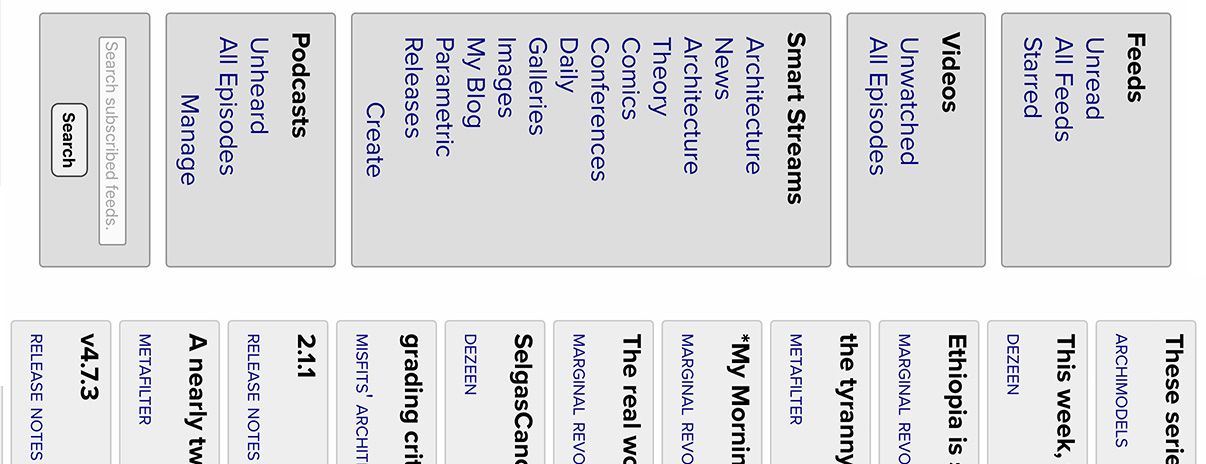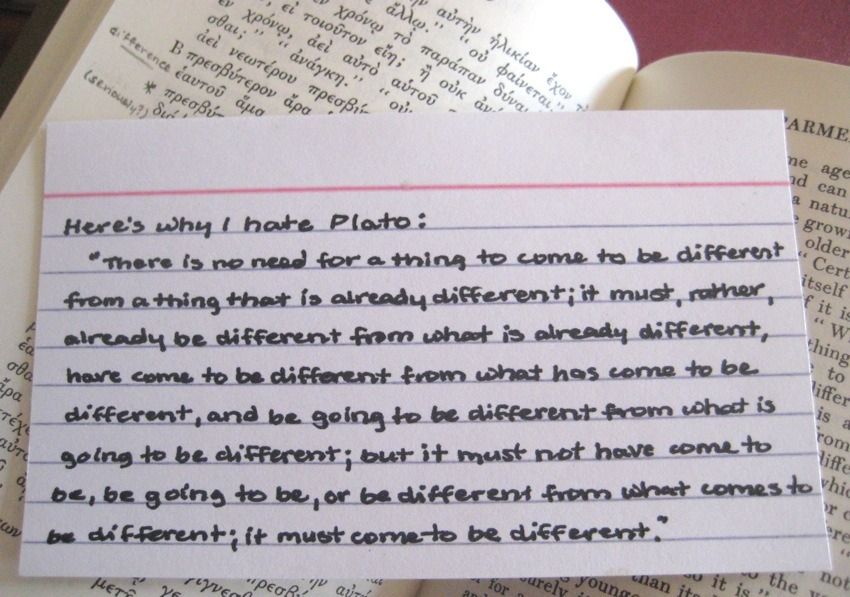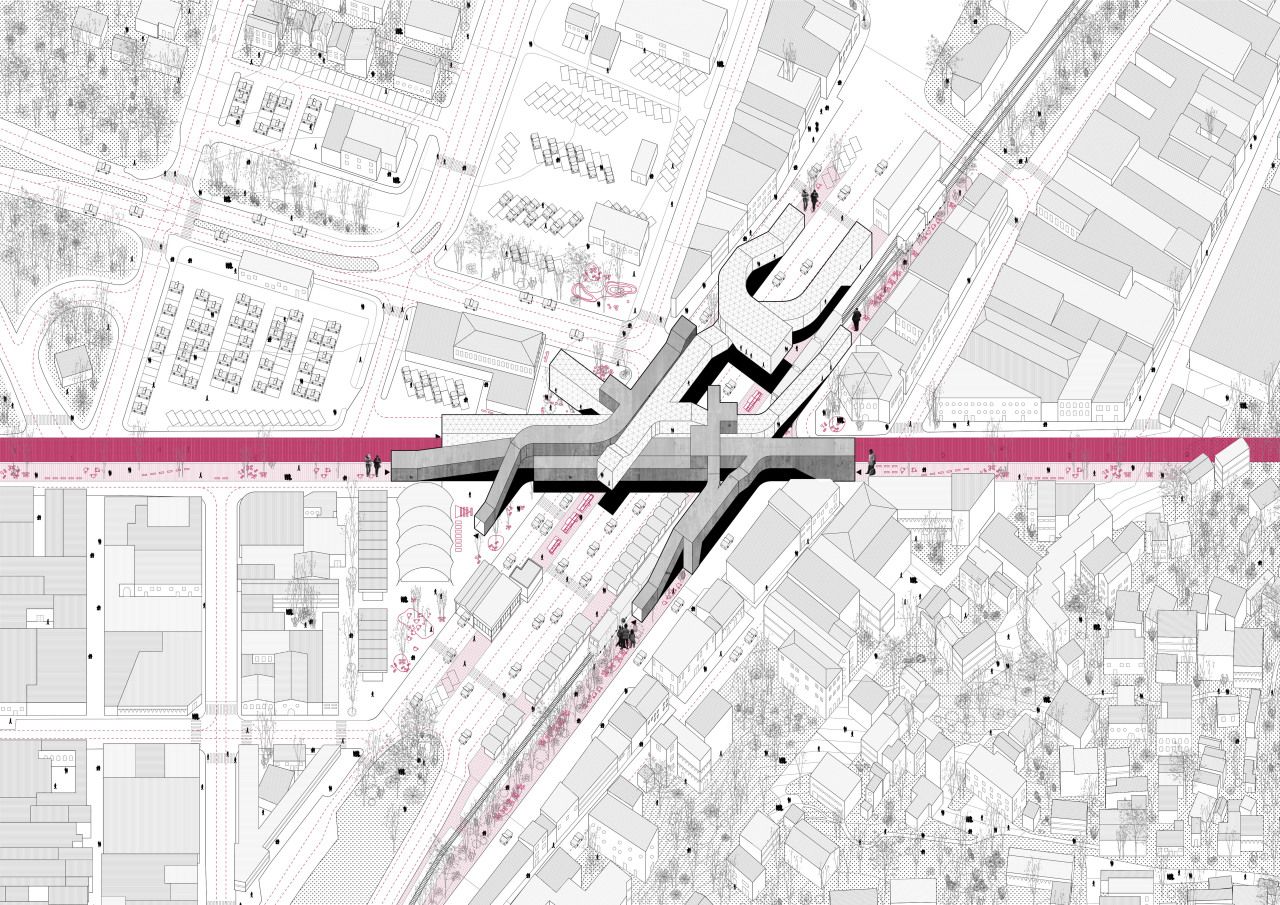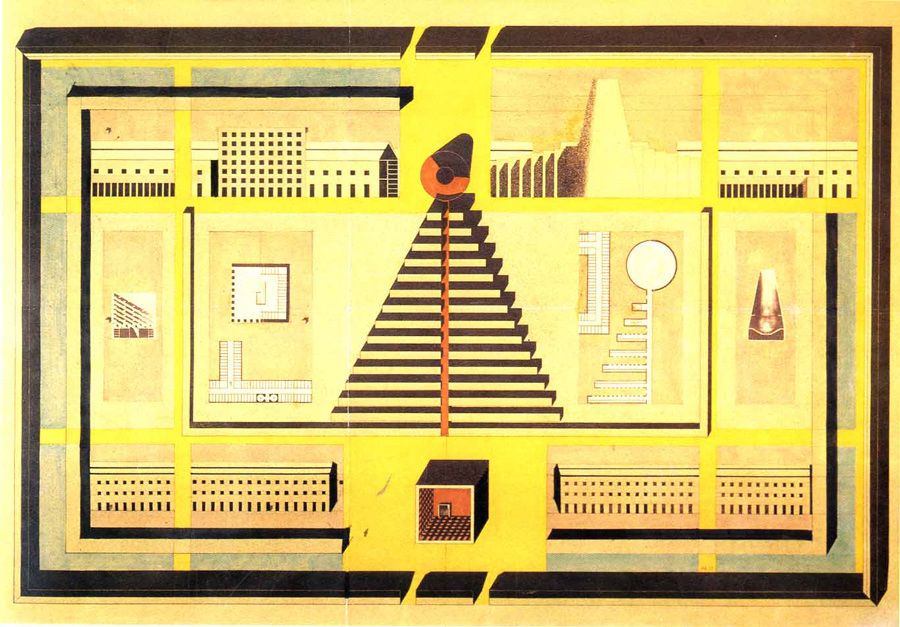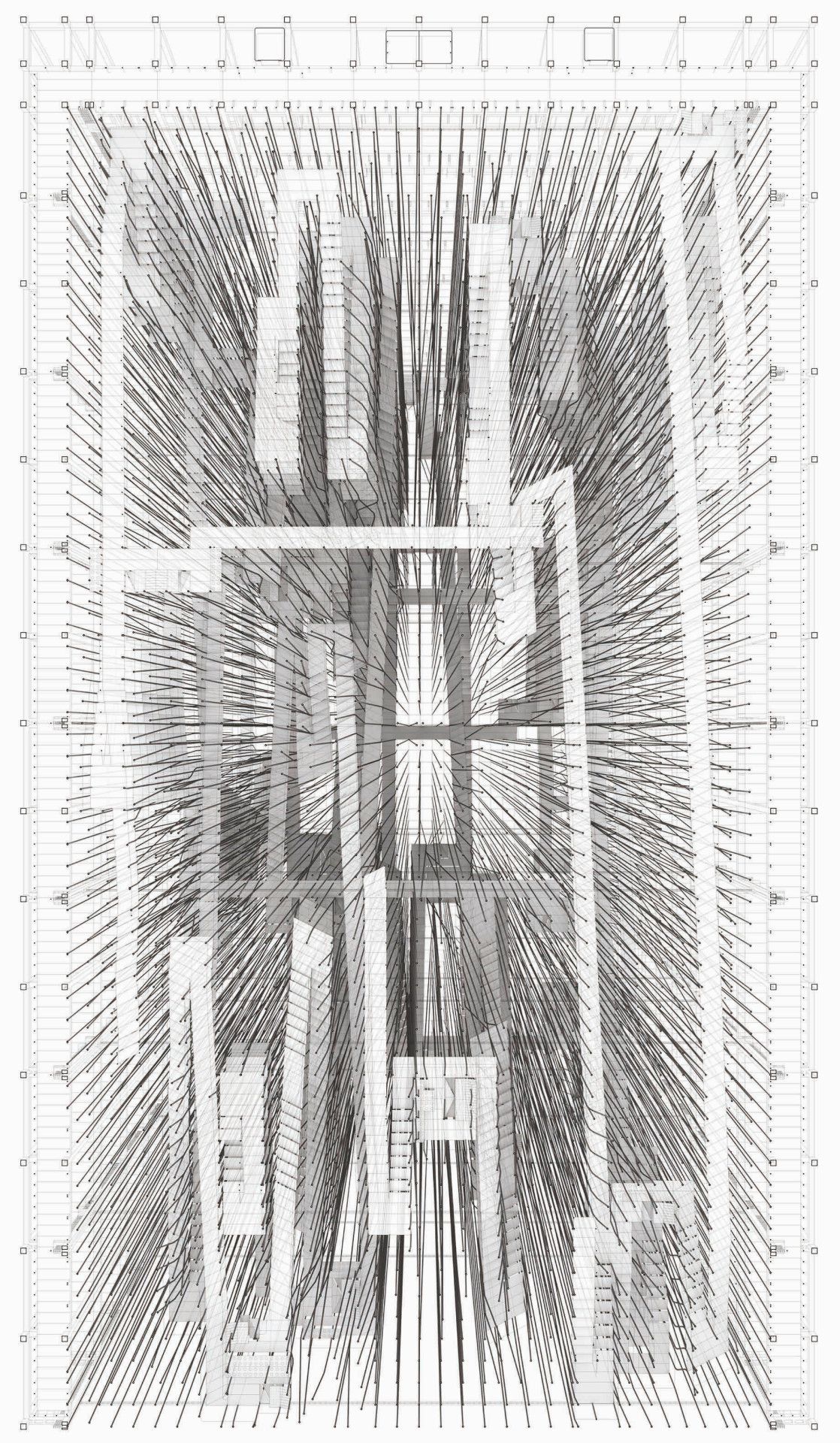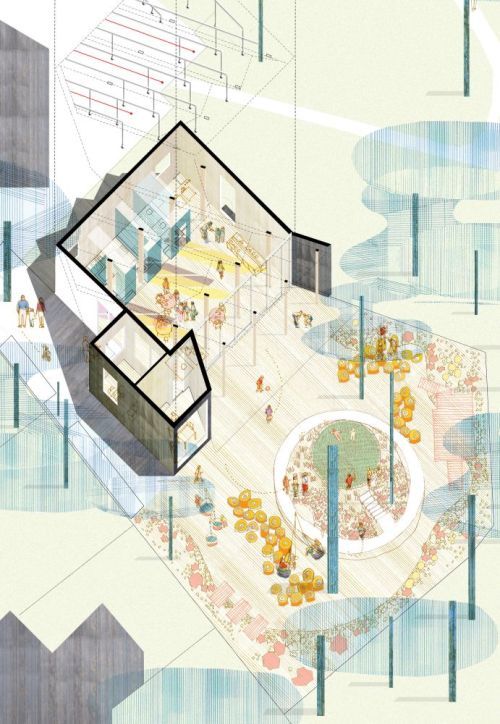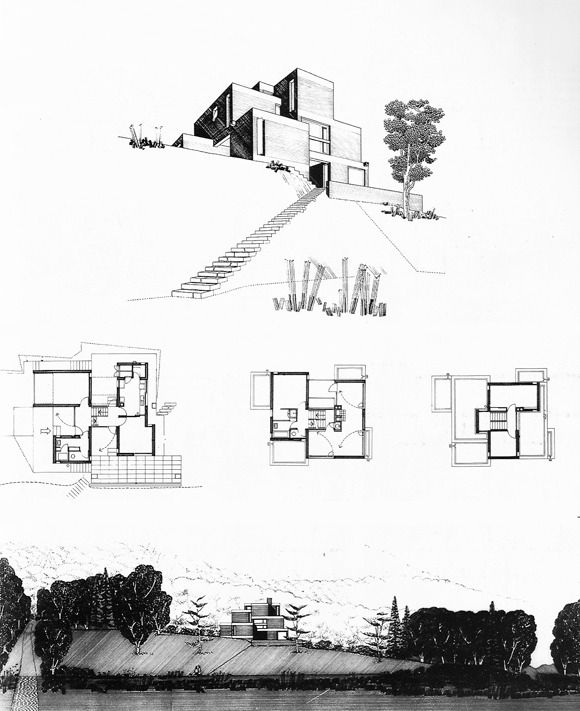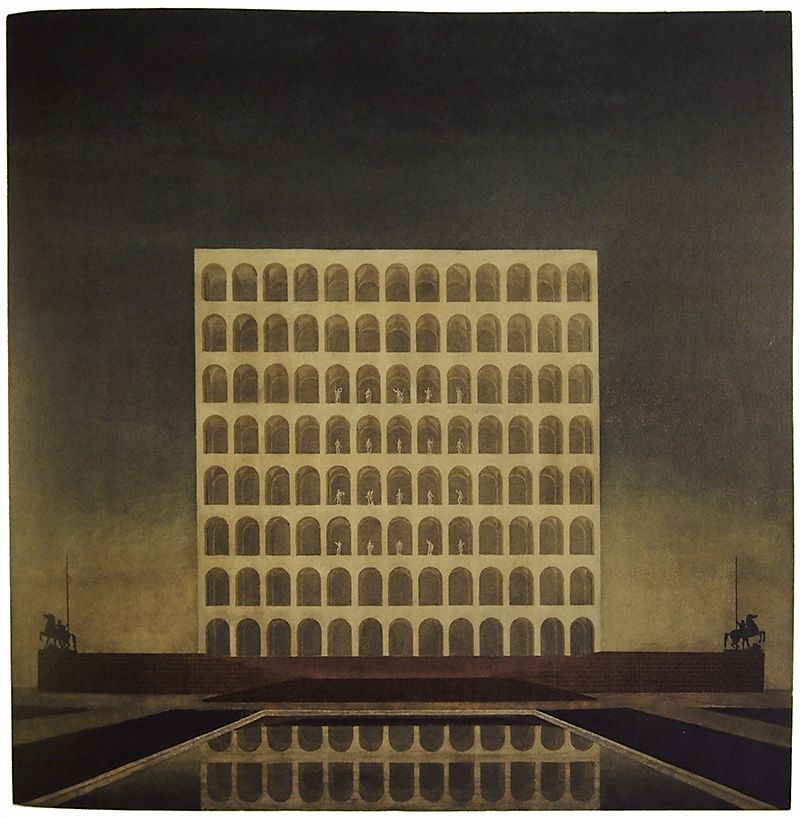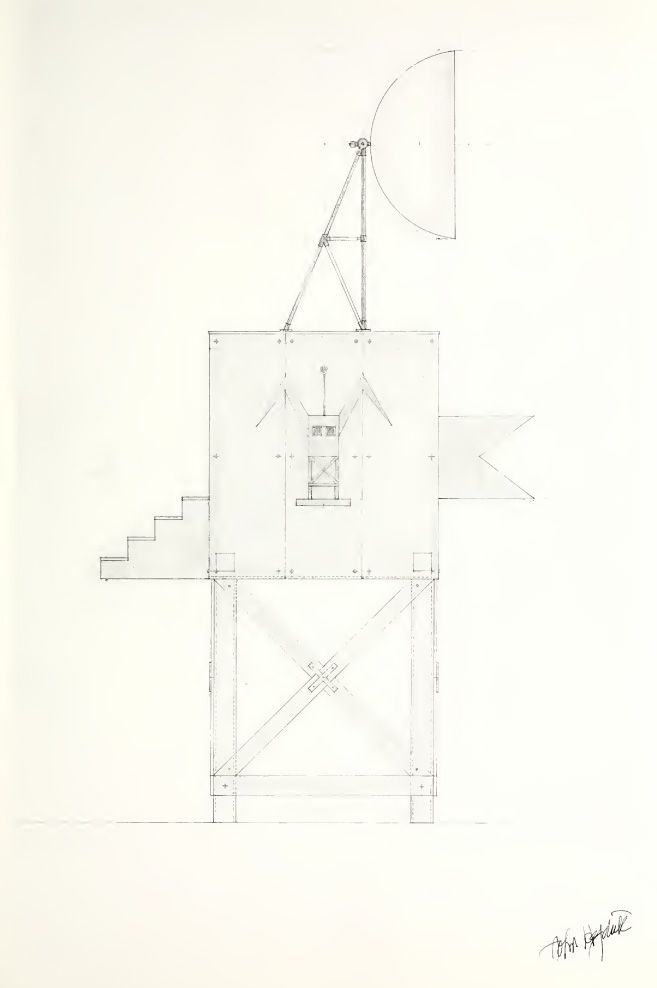Blogs wax and wane. Online publishing has become more diverse. So here’s something of a time capsule of what I enjoyed reading in 2013, and what I will (hopefully) be reading more of in the years to come.
Blogs
Adam Greenfield’s Speedbird
Adam is one of the sharpest urbanists around, providing a much needed critical counterpoint to many of the technologies and technologists that attempt to forecast the future of urbanism.
My primary beef with the book turns out to be the same I hold against the contemporary school of parametricists (which runs the entire gamut of seriousness, interest and credibility, from Zaha Hadid herself and her in-house ideologist Patrik Schumacher straight through to charlatans like Mitchell Joachim): that it fetishizes not merely form but the process of structuration. Or really, that it fetishizes the process of structuration to the detriment of usable form.
To make a fetish of these generative processes is to misunderstand their meaning, or to think that they are not already operating in our built environments. I promise you these algorithms of self-organization are always already there in the city — in the distribution of activities, in the dynamics of flow, in every last thing but the optical shape. The beehive’s form is epiphenomenal of its organizing logic, and so is the city’s. To reify such an organizing logic in the shape of a building strikes me as stumbling into a category error.
Extract from On Adaptive Ecologies. See also:
Ross Wolfe’s The Charnel-House
While Soviet art and architecture is far outside my academic wheelhouse, the level of research that Ross puts into his posts ensures that its never outside my personal interest.
But Murphy’s sympathy for interdisciplinary usages of “Theory” only extends so far. His criticism of the role it has played in recent architecture is twofold. At one level, he objects to its superficiality. Murphy has little patience for building proposals that look to press “Theory” into service in order to fulfil arbitrary stylistic ends. He therefore faults some practitioners for “bringing theory into architecture as a purely aesthetic device.” Relatively speaking, however, this part of Murphy’s criticism is rather tame. Its other side is, by contrast, far more damning. For insofar as it supposedly constitutes a form of “radical critique,” he contends, “Theory” functions to exonerate architects in advance for whatever oversights or questionable design decisions they might make. It becomes a kind of ritualistic gesture, simply “a way of avoiding a wider self-criticism.” By citing the right authors and referencing the right texts, the book alleges, architects are able to set up an ideological smokescreen so as to disguise the actual content of their activity.
Extract from Through Iron and Glass Darkly. See also:
- Architecture and Political Commitment
- Modernity for penguins — modernity for all!
- Soviet board-games, 1920-1938
Daniel Davis’ Blog
Daniel’s return to blogging came alongside a new website, a new doctorate, and a new job. Unchanged are the insights into how architecture intersects with digital technologies.
The distinction between using and making persists in much of the current discourse regarding parametric models. It persists explicitly in the likes of Roland Hudson’s (2010) PhD thesis, Strategies for Parametric Design in Architecture, when he continually refers to “completed parametric models” almost as if model making cumulates with a definite point of completion from which tool use and designing can begin (see chap. 2.1). It persists when Robert Woodbury (2010, 9) portrays the parametric model as a tool for adequately doing design tasks but never being the design task, saying “the task is foremost, the tool need only be adequate to it” (2010, 9). It persists when Benjamin Aranda and Chris Lasch (2005) write in their book, Tooling, that “the job of designing begins” (2005, 9) only once the tool is made. It persists in architectural education, says John Frazer (2006), because “design computation is still only seen by many as ‘just a tool’ and remote from the real business of creative design, which can be mainly blamed on the dull minds of those who were most part left to teach computing – often as if it were a separate subject.” It persists when Patrik Schumacher (2009a, 15) defines parametricism in terms of stylistic outputs coming from “parametric design tools and scripts.” And it persists when Mark Gage tells architects to “use computation, but stop fucking talking about it” (2011a, 1) and later instructs them to hire software engineers “because these tools are so new to architecture” (2011b, 133).
Extract from Chapter 8 – Discussion: Beyond Toolmaking. See also:
The Design Observer
The Design Observer has been a mainstay of online design writing for over a decade. Since absorbing Places Journal the site regularly serves up a broad range of great pieces on the practice and produce of architecture.
…No, the reason is probably shallower. I think many architects today use landscape in the way I have been describing to mask their desire to work by the means and in the generous and luxurious and deeply desirable language of abstraction, that (by the public largely under-appreciated but within architecture still correctly heroic) birthright of the Modern, rather than with the thin forms of representation of the Post-Modern, brought to you by the short-sighted idiots who sold out our birthright for magical sheetrock details. By equating abstraction with landform (as with the Austin City Hall), or with the processes that generate landform (as with the Diamond Valley High School), or with the palimpsestic layers of information built up in the human formation of landscape (as with the Vitra Fire Station), or with hidden landscape orders that must be brought to light (as with the Jewish Museum), these architects are cloaking the abstract with a mantle of landscape valor, while sidestepping the more contentious issue of language. Inadvertently or intentionally — it doesn’t matter — many architects today equate landscape and architectural form to keep alive the tradition of a building’s right to abstract sculptural presence.
Landscape is valued, while architecture is not. The rhetorical use of landscape in these instances is a form of deceit, a means-versus-ends intellectual slight of hand. These are timid times culturally. So maybe the gap between the pitch and the product is OK. Or not. Increasingly my experience is that maybe the gap doesn’t exist in architects’ minds, and we’ve actually come to convince ourselves of — to believe — the strange twisted content of our own misleading sales pitch.
Extract from Landscape is our Sex. See also:
- David Heymann’s A Mound in the Wood
- Tim Love’s Between Mission Statement and Parametric Model
- Stan Allen’s The Future That Is Now
Rachael Cayley’s Explorations of Style
Academics blogging about academia isn’t rare. Rachel’s Explorations stands out for its consistent and concise focus on the pragmatics of research and writing.
Most people will readily agree that more revision would improve their writing. But despite this widespread recognition of the importance of revision, many writers simply do not make revision an essential part of their writing process. One reason for this resistance is that many writers believe their own first drafts to be uniquely flawed; in other words, they think the weakness of the first draft comes from their lack of writing skill rather than from the intrinsic weakness of any first draft. As a result, they have little faith in their ability to fix what ails their writing. I suggest a shift in perspective: rather than worrying that your writing requires an exceptional amount of revision, try thinking that all writing requires a great deal of revision.
Extract from Committing to Extensive Revision. See also:
Fucktheory
Gender theory, philosophy, rants, and index cards.
Figure .
Figure . undefined. From Team Aristotle FTW .
See also:
- In Which Steven Pinker Is A Total Ignoramus Who Should Go Read A Fucking Book And Get Himself Some Fucking Education
- First As Farce, Then As Tragedy: Punk at the Metropolitan Museum
- The Unfair Sex
Jeremy Kun’s Math ∩ Programming
Given my non-existent computer science background, Jeremy’s blog is where I head to try and pick up some of the more fundamental concepts that underpin computation. Occasionally I understand what I’m reading. Those are the best times.
The glorious promise of Turing-completeness must be taken with a grain of salt. If we were to run within Life some wonderful computation that we might actually find useful as human beings, it would probably take longer than the life of the sun to complete. Indeed, we don’t actually care about computational speed or the prettiness of its output. Our true goal was the theoretical proof that this model is equivalent in power to a Turing machine. This has a number of profound implications (most of which have been voiced before by the Big Names of mathematics).
Specifically, we initially started with a very simple set of rules. From this, we observed much chaotic behavior, but found some order in still patterns, gliders, and oscillators. After thoroughly mastering these pieces, we suddenly found the ability to compute anything that can be computed! All of this order was hiding in chaos.
Extract from Turing Machines and Conway’s Dreams. See also:
- Metric Spaces — A Primer
- Prime Design
- Why there is no Hitchhiker’s Guide to Mathematics for Programmers
Scenario Journal
Just as the discourse around landscape urbanism seems to be fading and fracturing, along comes this Penn-backed online journal to carry the banner.
Throughout the project, which had been primarily focused on the history of urban form, a constant theme was how best to represent infrastructure. To accurately describe the infrastructural object meant locating it between inputs of various scales (raw materials in far-off mines or fields, sites of connection for transport, neighborhoods needing to be connected with banking centers or prison ships throughout the UK and its colonies) and outputs at the urban scale (electricity, beer, water, playgrounds). A consistent scale and type of drawing was impossible as the traditional methods of representation that apply to buildings could not grapple with the range of environmental effects. Likewise, a graphic abstraction of network diagrams could not effectively show how projects had reacted to specific events on the ground: forms of landownership, neighborly rivalries and local resistance or promotion. This problem became a recurring discussion in the seminar and reflects another fact of architectural methodology: as architects, we draw much more than we build. In order to find an architectural approach to the infrastructure that is so visibly a part of contemporary life, it is also important to ask how we can draw it.
Extract from Skeleton Forms: The Architecture of Infrastructure. See also:
- Aqueous Ecologies: Parametric Aquaculture And Urbanism
- Productive Filtration
- The Humanity of Infrastructure: Landscape As Operative Ground
Paul Prudence’s DataisNature
In Paul’s own words: “Dataisnature’s interest in process is far and wide-reaching – it may also include posts on visual music, parametric architecture, computational archaeology, psychogeography and cartography, experimental musical notational, utopian constructs, visionary divination systems and counter cultural systems.”
Halprin’s open-ended approach using a personalised ideographic system allowed him to design a range of scores to choreograph the movement of elements in urban parks, plazas and cultural centres. The process he used allowed him to create designs for some of the most daring, exploratory, and potentially dangerous (and therefore exciting) public spaces in existence. His Motations were guides for the intended motion of people through space as well as scores for actual moving parts of the architecture itself – such as water in fountains. Essentially Halprin ‘construed landscape architecture as a form of narrative’
Extract from Lawrence Halprin’s Motations & Ecoscores. See also:
- Stanley Tigerman & G. T. Crabtree – The Formal Generators of Structure
- Victory Over the Sun – El Lissitzky’s Drawings for Suprematist Automatons
- Neri Oxman – Biomemetic Encapsulations of the Body
Sucker Punch
An eclectic mix of the theory, practice, and speculations of various computational designers. Projects full of obscure rhetoric and loose rationalisations sit alongside those evidencing incredible craftsmanship and innovation.
The necessity to engage complexity as a design tool has increased due to the increased fidelity and quantity of data available to the architect. The need is clearly evident in contemporary work involving environmental responsiveness. Within the environmental analysis of a project, simulation is already being leveraged to produce sophisticated understandings of context. However, these findings are applied to an architectural parti in either purely responsive, linearly parametric tectonic resolutions, or in the literal translations of diagrammatic output into totalizing form. The implication of continuing to operate in this manner is that, given the ever-increasing sophistication of received analytical content, disciplinary intention becomes increasingly submissive. Our diagrammatic approach is no longer capable of producing a dialogue with fine-grained contextual inputs, as it operates at too course a resolution. This is a path to homogenization and a lack of relevance for our profession.
Extract from Embrace the Complex. See also:
Uncube Magazine
Launched as a ‘digital magazine’ the site’s layout certainly aspires to the precision and diversity typically presented on glossy paper stocks. Putting aside the equally maddening and fascinating design, the content of its posts and issues is consistently great.
The disastrous City of Culture of Galicia outside Santiago de Compostela, designed by Peter Eisenman, sums up the excesses of the system with its empty rhetoric and extravagant and meaningless formalistic gestures. The folds of the project were sold to American academia through references to Deleuze (Le Pli), and to the gullible Galician locals through computerised transformations of the town plan of the old city of Compostela and allusions to the pilgrims of Santiago de Compostela. Far from being anchored in the local context, the project has decapitated Monte de Gaias and replaced it with a phony landscape with curves like those of a fun-fair roller coaster. These cynical intellectual manipulations cannot mask the reality of structures resembling supermarkets twisted about with algorithms and camouflaged with a thin veneer of granite (imported from Brasil!).
Extract from Containers Without Content. See also:
LMN Tech Studio
Back in the early days of Grasshopper, there were many blogs dedicated to exploring the software’s limits and educating its novice users. Most of these blogs are defunct. LMNts is one of the few that still occasionally posts interesting work and downloadable code.
The decision on how to transition between platforms usually comes down to the question: “Do we need to transfer the data?” Sometimes it’s perfectly valid to import geometries without taking the time to translate the data behind them. Other times it’s important that we create native geometry and data so that we can utilize Revit’s scheduling or to allow further manipulations of the geometry after it’s inserted. For projects that do require native geometry we then have to decide on the most efficient way to go between software platforms. Sometimes someone just has to put in the hours to remodel the geometry and input the data, but we’re increasingly trying more sophisticated methods to go between the different platforms.
Extract from Taking a Grasshopper for a Walk. See also:
- Processing and Optimization Solvers
- Med Mart 4: Facade Design Coordination
- Acoustic Reflection Form Finding
Image Blogs
The Archdaily, Dezeen, and Architizer style super-blogs now post incredible quantities of projects. Unfortunately, most of these projects lack interesting qualities.
In contrast, tumblr has emerged as an excellent source for visual material. Material that — largely — exists outside the PR echo chambers and instead focuses on personal work, historic precedents, and particular details.
Architecture Paste Book
Figure .
Figure . undefined. Post 73888008707 .
Architectural-Review
Figure .
Figure . undefined. Border-LESS Ambos Nogales, Lidia Ordas Diaz, ETSAM, 2015 .
James Pattullo’s Black Tissue
Figure .
Figure . undefined. Terraces of Yuanyan .
But Does it Float
Figure .
Figure . undefined. Even in a place I had only read about, I still read about other places .
Daniel Brown
Figure .
Figure . undefined. ecording and Projecting Architecture .
Drawing Architecture
Figure .
Figure . undefined. Michal Radvan .
Fabricio Mora
Figure .
Figure . undefined. Montpelier Community Nursery - AY Architects .
The New Aesthetic
Figure .
Figure . undefined. Twitter/iowatch .
Henry Stephen’s The Paper City
Figure .
Figure . undefined. Stage House .
Procrete
Figure .
Figure . undefined. House in the Chilterns, 1956. James Frazer Stirling .
RNDRD
Figure .
Figure . undefined. Ernesto Bruno La Padula. Envisioning Architecture .
Socks Studio
Figure .
Figure . undefined. OHN HEJDUK: THE RIGA PROJECT (1987) .
